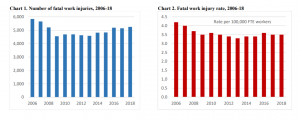Our Conferences are Canceled: Now What? (Part 3)
04/29/2020

“The number of non-fatal injuries has decreased, but fatal ones are up,” said Phil Molé, EHS and Sustainability Expert in a recently recorded On-Demand webinar. “OSHA’s Recordkeeping Standard: Your Guide to Compliance” is a topic that Molé planned to present this year before COVID-19 caused our conferences to be canceled or postponed. As the VelocityEHS Senior Marketing Events Manager, I decided to bring this content to you.
The topic of recordkeeping is now more important than ever as organizations that have been working remotely gear up to re-enter the workplace. To avoid additional workplace injuries, leaders must be aware that, since workers have been at home adhering to the physical distance guidelines set by the CDC, they may have become deconditioned, meaning the physical workplace tasks they could do a month ago may be difficult for them to do now. If strategies aren’t implemented to make their jobs easier upon return, a rise in injuries could occur. [Restarting Work After Covid-19: 7 Tips To Help Employees Prepare].
Additionally, workers in industries deemed essential, such as healthcare, are faced with increased demand for their services during these challenging times. Proper injury and illness recordkeeping is essential in these industries to avoid compounding safety risks.
Occupational Health and Safety (OHS) professionals are not only responsible for ensuring a safe work environment, but they must also stay current on injury and illness recordkeeping regulations. Recordkeeping is about protecting and preserving lives. The data magnifies the hazards in the workplace so that deaths or other serious injuries can be prevented, or corrected to prevent recurrences.
For good data, safety managers must maintain accurate records. To do so, they must understand what is and isn’t a recordable injury or illness according to OSHA’s Recordkeeping Standard. Even veteran EHS professionals sometimes have difficulty making those determinations.
Test your Recordkeeping IQ
How well do you know OSHA’s criteria for recordable injuries and illnesses? Review the scenarios below, based on real cases OSHA addressed through guidance and letters of interpretation (LOIs).
- Scenario 1: An employee injures his shoulder at work, visits a physician, and is instructed to take over-the-counter ibuprofen and use as directed. Is this recordable? No. The treatment is considered first-aid since the recommended medication was non-prescription strength. If it were a prescription-level dosage of the over-the-counter medication, the case would be recordable.
- Scenario 2: An employee visits the doctor for a work-related injury and receives a prescription but doesn’t take it. She informs her supervisor of her decision not to take it. The company doctor reviews the case and feels the prescription was not necessary. The first doctor later agrees. Is this recordable? Yes. According to OSHA, once a prescription is given, the case becomes recordable despite the second doctor’s opinion and the first doctor’s change of mind.
- Scenario 3: An employee has pre-existing rotator cuff tendonitis. He assists the company in a move that requires heavy lifting and, afterwards, his shoulder is sore. He visits the doctor, who determines the tendonitis is now a rotator cuff tear and prescribes Naprelan 375 for pain and swelling. Is this recordable? Yes. An event or exposure in the workplace significantly aggravated a pre-existing injury or illness, and the administration of medical treatment in the form of a prescription drug makes the injury recordable.
Common Recordkeeping Mistakes
There are many common recordkeeping mistakes, and most result from misunderstanding the rules, lack of reporting and documentation, or not staying current on the latest regulations. Some of the most common mistakes are listed below:
- Not fully completing or signing the OSHA recordkeeping Form 300A (Summary of Work-Related Injuries and Illnesses).
- Checking the boxes for both “job transfer or restricted” and “days away from work” for an injury on the Form 300 when both apply, rather than classifying only as the more serious outcome of “days away from work.” This results in double-counting the injury on Form 300A, which is especially important to avoid now that some establishments must submit electronic 300A data directly to OSHA.
- Failing to list both the number of days away from work and the number of days with job transfer or restrictions for incidents involving both lost workdays and job restrictions/transfers.
- Listing the number of workdays missed (or on transfers or restrictions) rather than the calendar days, starting with the day after the injury. Many who complete Form 300 mistakenly think they don’t need to count days such as holidays, accepted PTO days, or other days on which the employee would not have worked.
- Not including temporary or contract workers on OSHA occupational injury and illness records.
- Classifying certain types of illnesses as injuries. For example, flash burn is an illness, not an injury!
- Failure to submit recordable injuries or illnesses on the OSHA Form 300 within 7 calendar days of notification.
- Underreporting the “total hours worked by all employees last year” in the entire establishment on the OSHA Form 300A
- Not recording a case number (assigned to each recordable injury). This helps maintain a recordkeeping system in good order.
- Not maintaining OSHA injury and illness records because the company has claimed “small employer” exemption (according to OSHA, an employer is generally exempt from maintaining these forms if the company—not the establishment—had ten or fewer employees the previous year).
- Failure to record the standard threshold shifts (STS) from occupational noise exposure.
- Not reporting enough details when documenting a recordable event.
- Not documenting the number and reasons for non-recordable cases such as first aid. While the Recordkeeping Standard does not require documentation of these incidents, tracking them is important to the identification and control of workplace hazards and risks.
- Not knowing what an OSHA recordable work restriction is, or misunderstanding “light duty” restrictions.
- Not giving proper weight to the testimony of the injured employee. This often happens because of the belief that if the employee doesn’t immediately report the incident, the incident is in some way questionable and doesn’t need to be recorded.
- Confusion between over-the-counter medication and prescription strength when determining if usage of medication constitutes medical treatment according to OSHA’s definition.
What Does the Data Say?
The good news is that data shows that non-fatal injuries are down, meaning that companies have been successful in reducing the number of common workplace injuries such as musculoskeletal disorders (MSD). The bad news is that the data also shows that fatal injuries have increased, meaning that companies have not reduced the big risks, the ones that cause fatalities and serious injuries. See the figure below, showing recent trends in fatal injury numbers reported by the Bureau of Labor Statistics (BLS) in their latest National Census of Fatal Occupational Injuries and Illnesses.

“Either injuries aren’t getting reported, safety isn’t being observed, or companies aren’t identifying and reducing the big risks, the ones that cause fatalities,” says Molé. “We are seeing the opposite of that. While we’re focused on recording criteria and OSHA recordkeeping standards, the data shows the importance of not just focusing on recordable injuries and illnesses, but also on near misses; those indicate that something is wrong and they take a toll on the pocketbook, too.”
Companies that want to get more serious and proactive about safety need to actively document and address risks and hazards however they learn of them, even if they haven’t yet resulted in recordable injuries and illnesses.
The recordkeeping rules ensure employers’ injury and illness records and incidents get communicated to OSHA, as well as to provide employers with information they can use to improve safety within their workplaces The data provides trends and patterns, helps determine the need for new regulations, and confirms that current standards are working as planned.
For the most up-to-date regulations and recordkeeping rules and a more detailed discussion of recordkeeping compliance and common mistakes, watch this On-Demand webinar.
Read Past Presentation Summaries






